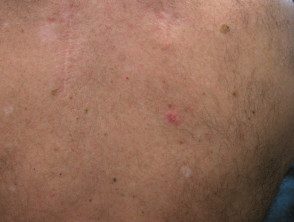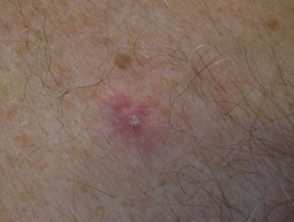Ad
Skin cancer
Application to facilitate skin self-examination and early detection. read more.
Primary cutaneous adenoid cystic carcinoma (PCACC) is a rare skin Cancer it is believed to originate in the sweat ducts.
What are adenoid cystic carcinomas?
PCACC is part of a group of tumors called adenoid cystic carcinomas. They share similar characteristics under the microscope (see pathology adenoid cystic carcinoma) but have clear differences in clinical behavior and forecast. The types of adenoid cystic carcinoma include:
- Cutaneous (described here)
- Salivary (most common)
- Airways (lung, trachea, sinuses)
- Tear glands (eyelids)
- Chest.
The cutaneous type (PCACC) progresses slowly and rarely spreads to other areas of the body. It has a better prognosis than others in the group, such as the type of salivary gland. The cause is unknown.
Who is at risk for primary cutaneous adenoid cystic carcinoma?
PCACC generally affects adults with fair complexions. It typically occurs between the ages of 50 and 70. It occurs in men and women equally and more frequently with increasing age.
While immunosuppression increases the risk of some other cancers, such as scaly cell carcinoma (SCC), this does not increase the risk of PCACC.
Due to the rarity of this cancer, other risk factors have not yet been identified.
What does PCACC look like?
PCACC is generally a firm skin-colored solitaire nodule or license plate. It grows slowly over months or years. It most commonly occurs on the scalp. Other sites include the head, face, neck, trunk, and perineum.
Primary cutaneous adenoid cystic carcinoma

Primary cutaneous adenoid cystic carcinoma

Primary cutaneous adenoid cystic carcinoma
Treatment of PCACC
Treatment for PCACC depends on its size and location. Most lesions are removed surgically. A wide margin (for example, 1 cm) is recommended to reduce the risk of reappearanceas it is often difficult to determine the boundary between cancer and normal skin. Mohs micrographic surgery has been used in some cases where it is difficult to achieve a wide margin around the tumor.
Radiotherapy commonly used as attached therapy, and may be recommended if the margins are narrow or injury it has been incompletely excised.
What happens after the treatment?
While most PCACCs are cured with initial treatment, a large proportion (reports range from 22 to 70%) recur in the original location. This is more likely if the histology has shown perineural invasion, incomplete removal, or narrow margins. Recurrence usually occurs within 5 years, although there are reports of recurrence up to 35 years after the initial extraction.
Metastatic PCACC
Spread to other areas of the body (metastasis) It's very weird. When it occurs, PCACC most commonly spreads to the lungs.
Metastatic PCACC is treated with a combination of surgery excision, radiation therapy and chemotherapy.


